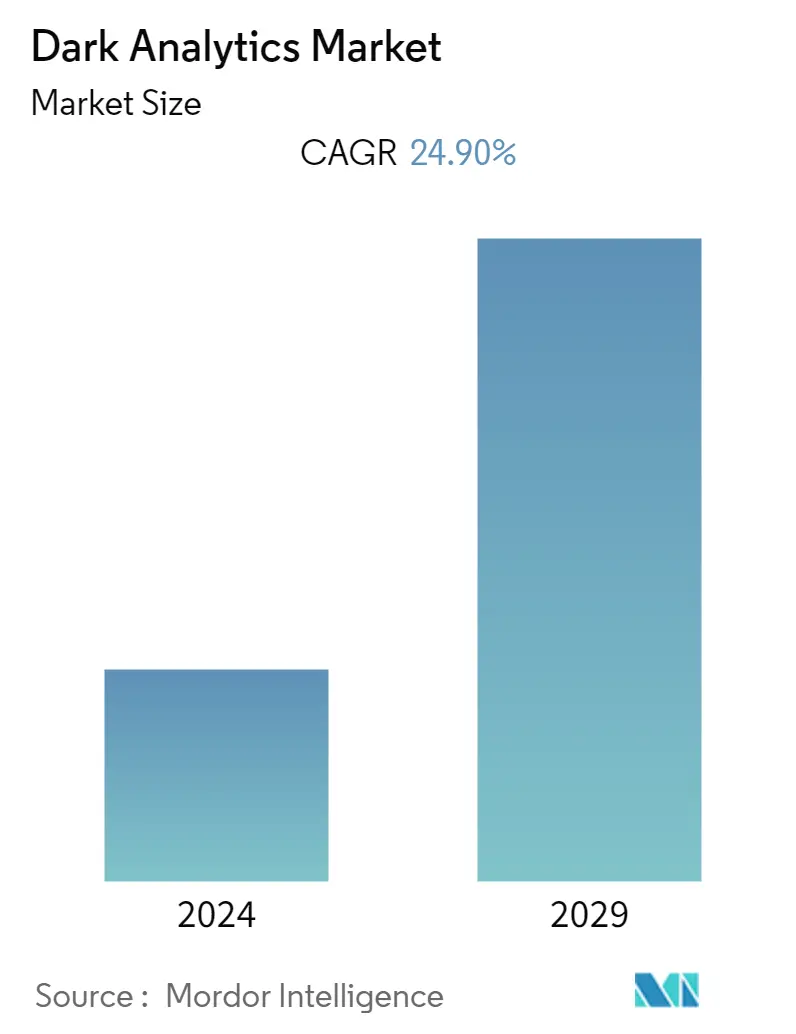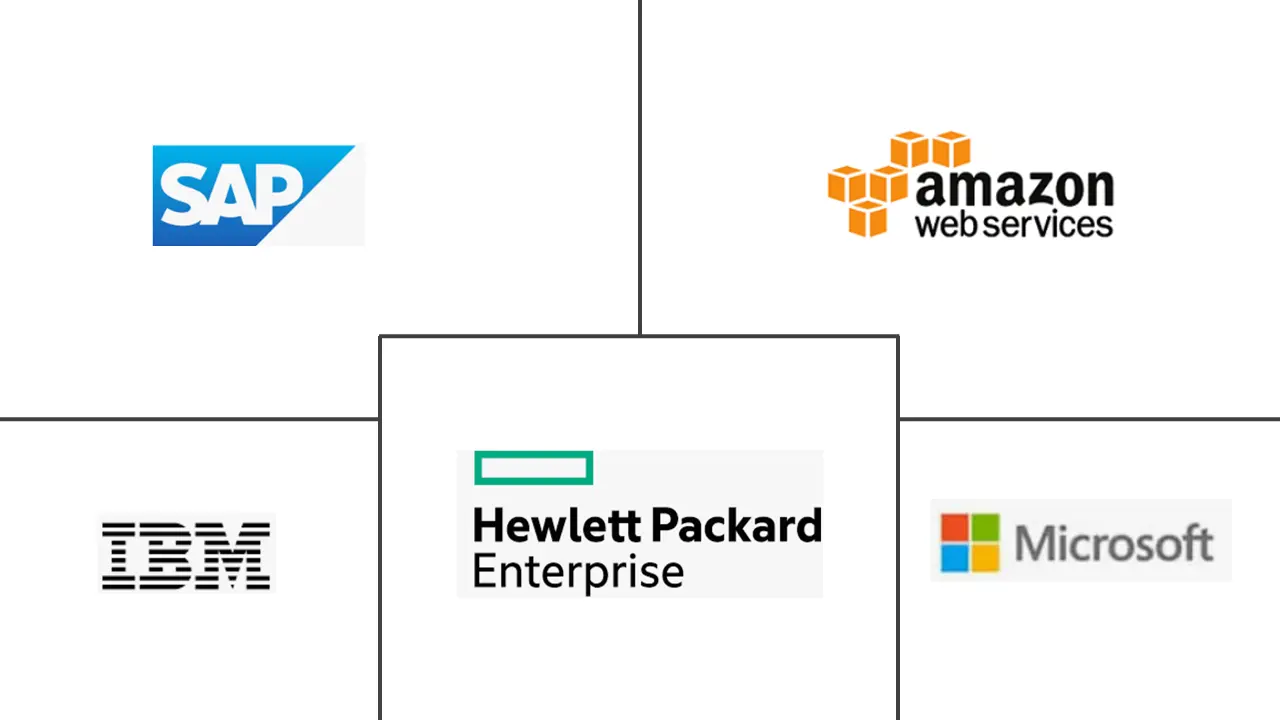Market Size of Dark Analytics Industry

| Study Period | 2019 - 2029 |
| Base Year For Estimation | 2023 |
| CAGR | 24.90 % |
| Fastest Growing Market | North America |
| Largest Market | North America |
| Market Concentration | High |
Major Players
*Disclaimer: Major Players sorted in no particular order |
Dark Analytics Market Analysis
The dark analytics market is poised to register a CAGR of 24.9 percent during the forecast period. As data security becomes a more significant focus, companies are exploring new ways to analyze data, such as dark data that isn't typically used in business analysis, to ensure it doesn't create security risks. According to a survey, IBM estimated that about 90% of the data generated by sensors and analog-to-digital conversations needs to be utilized.
- Vast amounts of data are collected from various sources, including the internet, social media, and other IoT systems. This data is expanding exponentially, but it is not organized or examined for potential consequences; instead, it is merely maintained for historical purposes. According to IBM, 60% of this gathered data loses its usefulness immediately.
- The main thing that is driving the growth of the dark analytics market is getting insights for making decisions by analyzing real-time data from key business processes like sales, production, and distribution trends.
- This dark data, if used appropriately, can generate a lot of revenue. For example, with the help of data analytics, the marketing division can understand which products are most demanded by particular target groups and thus look for promotions and offers to sell them to increase their performance.
- In 2022, Ocient polled 500 IT managers to find out what they thought about data analytics.62% agreed that data analysis is essential for business planning and company strategy. 64% of these already use hyperscale datasets to draw insights and use them in decision-making. 78% of this group realized faster data analytics generates higher revenue. The data should be analyzed quickly to stay ahead of the competition and adapt to changing market needs.
- The application of dark web intelligence benefited from COVID-19. The pandemic encouraged organizations to look into various commercial expansion options. Businesses believed they could extract useful information from this underutilized data to help with revenue development. For instance, unstructured customer geolocation and sentiment data were used to assist business and marketing strategy after it was analyzed for traffic patterns.
- This dark data can pose significant dangers to data protection procedures and accrue unanticipated expenditures if not managed. Recent studies show that almost 50% of a company's data is unstructured or never structured, which adds to an annual storage cost of $26 million.
Dark Analytics Industry Segmentation
Dark analytics is the analysis of dark data present in enterprises. Dark data is information that is obtained through various computer network operations but is not utilized in any way, shape, or form. All that businesses stack and store for use in various business operations is just raw data or information in the form of text, tables, and figures.
The dark analytics market is segmented by type (predictive, prescriptive, and descriptive), end-user vertical (BFSI, healthcare, and government), and geography.
The market sizes and forecasts are provided in terms of value (USD million) for all the above segments.
| By Type of Analytics | |
| Predictive | |
| Prescriptive | |
| Descriptive |
| By End-user Vertical | |
| BFSI | |
| Healthcare | |
| Government | |
| Telecommunications | |
| Retail & E-commerce | |
| Other End-user Verticals |
| Geography | ||||||
| ||||||
| ||||||
| ||||||
|
Dark Analytics Market Size Summary
The dark analytics market is experiencing significant growth, driven by the increasing need for businesses to harness unstructured data, often referred to as dark data, to gain insights and make informed decisions. This market is expanding rapidly as organizations recognize the potential of analyzing data that is typically overlooked, such as sensor data and unstructured customer interactions, to enhance decision-making processes in areas like sales, production, and distribution. The COVID-19 pandemic further accelerated this trend, prompting businesses to explore new avenues for revenue growth by leveraging dark data for strategic insights. The retail and e-commerce sectors, in particular, are witnessing a surge in dark data generation due to digitalization, offering retailers the opportunity to refine their strategies and improve customer experiences through advanced data analytics.
North America is poised to dominate the dark analytics market, benefiting from its early adoption of analytics technologies and the presence of major analytics providers. The region's growth is further supported by the rise of machine learning, AI technologies, and the widespread adoption of IoT. Companies like IBM, Microsoft, and SAS Institute are key players in this market, driving innovation through strategic partnerships and technological advancements. Initiatives such as Dataiku's collaboration with Deloitte and AWS's Data Lab Program in India highlight the industry's focus on building scalable data analytics capabilities. These developments, along with the introduction of platforms like KNIME hub and HealthLake, underscore the market's trajectory towards deeper integration of AI and machine learning, aiming to transform dark data into valuable business insights.
Dark Analytics Market Size - Table of Contents
-
1. MARKET DYNAMICS
-
1.1 Market Overview
-
1.2 Market Drivers
-
1.2.1 Increasing Adoption Rates of Machine Learning and Artificial Intelligence
-
1.2.2 Rapid Growth in Generated Data Volume and Variety Owing to Adoption of IoT
-
-
1.3 Market Restraints
-
1.3.1 Security Concerns
-
-
1.4 Industry Attractiveness - Porter's Five Forces Analysis
-
1.4.1 Bargaining Power of Buyers/Consumers
-
1.4.2 Bargaining Power of Suppliers
-
1.4.3 Threat of New Entrants
-
1.4.4 Threat of Substitute Products
-
1.4.5 Intensity of Competitive Rivalry
-
-
-
2. MARKET SEGMENTATION
-
2.1 By Type of Analytics
-
2.1.1 Predictive
-
2.1.2 Prescriptive
-
2.1.3 Descriptive
-
-
2.2 By End-user Vertical
-
2.2.1 BFSI
-
2.2.2 Healthcare
-
2.2.3 Government
-
2.2.4 Telecommunications
-
2.2.5 Retail & E-commerce
-
2.2.6 Other End-user Verticals
-
-
2.3 Geography
-
2.3.1 North America
-
2.3.1.1 United States
-
2.3.1.2 Canada
-
-
2.3.2 Europe
-
2.3.2.1 United Kingdom
-
2.3.2.2 Germany
-
2.3.2.3 Rest of Europe
-
-
2.3.3 Asia Pacific
-
2.3.3.1 China
-
2.3.3.2 Japan
-
2.3.3.3 Australia
-
2.3.3.4 Rest of Asia-Pacific
-
-
2.3.4 Rest of the World
-
2.3.4.1 Latin America
-
2.3.4.2 Middl-East & Africa
-
-
-
Dark Analytics Market Size FAQs
What is the current Dark Analytics Market size?
The Dark Analytics Market is projected to register a CAGR of 24.90% during the forecast period (2024-2029)
Who are the key players in Dark Analytics Market?
IBM Corporation, SAP SE, Microsoft Corporation, SAS Institute and Amazon Web Services Inc. are the major companies operating in the Dark Analytics Market.

